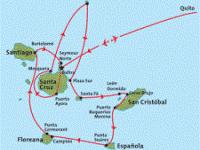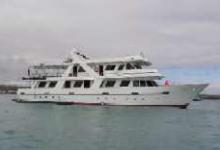Recently Viewed Cruises
- San Jose, Classic Galapagos ex Quito ReturnAdd to favourites
- Akademik Ioffe, Antarctic Circle Adventure ex Ushuaia ReturnAdd to favourites
- Aegean Odyssey, Grand Highlights of the Classical World ex Istanbul to VeniceAdd to favourites
- Aegean Odyssey, View of Jerusalem is History of World ex Cairo to IstanbulAdd to favourites
- Aegean Odyssey, Grand Voyage to Ancient Wonders ex Cairo to AthensAdd to favourites
- Ab Fab Oosterdam
- Catch up on Cruising: Latest cruise news in bite size
- Catch up on Cruising: Latest cruise news in bite size
- Catch up on Cruising: Latest cruise news in bite size
- Catch up on Cruising: Latest cruise news in bite size
- Frequently Asked Questions
-
San Jose, Classic Galapagos ex Quito Return
Nights 9 Ship San Jose Star Rating Specialty Departs Quito, Ecuador Sailing 2013: 18 Feb ,4 Mar ,18 Mar ,1 Apr ,15 Apr Ports of Call Quito, Baltra, Isla Genovesa, Isla Santa Fe, San Cristobal Is, Espanola Island (Punta Suarez), Bahia Gardner, Isla Floreana, Bartolome Island, North Seymour Please enquire about this cruise for pricing.
7 Night Cruise sailing from Quito roundtrip aboard San Jose. 1 night hotel stay pre-cruise and post-cruise in Quito.
Day 1: Quito - Arrival day
There is a pre-departure meeting in the evening at 6pm when you meet others travelling on your cruise to the Galapagos Islands. Note: Quito is located at 2850 metres above sea level. At this altitude you may experience some of the milder effects of altitude sickness, such as dizziness, insomnia and a shortness of breath. If so, we recommend you avoid any strenuous activity. 1 night hotel stay.
Day 2: Fly Quito to Baltra. Visit Mosquera Island.
Meals included: 1 breakfast, 1 lunch, 1 dinner
This morning we are transferred to the airport for our flight to the Galapagos Islands. Lunch is normally served on the flight. On arrival at Baltra Airport in the Galapagos you must pay the US$100 arrival tax for entry to Galapagos National Park. This is best done using cash, as using credit cards can be a time consuming process. We are met in the arrival hall of the airport by our National Park Guide, and transferred to the 'San Jose'.
Once settled on board, our cruise departs for the small sandy island of Mosquera, it's a relaxing, picturesque stop. Along the rocks and in the tide pool, sally lightfoot crabs (red lava crabs) scamper back and forth, skipping across small pools of water in search of food. These crabs with their bright red shell tops and blue under shells are stunning against the black lava.
Ever aware of movement around them, the sally lightfoot is quick to escape from any approaching movement, a natural defencse that helps protecting them from their natural predators, herons, moray eels and hawkfish. This quick escape technique seems in stark contrast to the unabashed way the crabs climb over the sedentary marine iguanas.
Day 3: Genovesa Island and Darwin Bay
Meals included: 1 breakfast, 1 lunch, 1 dinner
The archipelago's northeast outpost, it takes an overnight sail to reach Genovesa, but it's undeniably worth the voyage. Dolphins are often spotted in the waters around Genovesa, while the island itself is one of abundant beauty, with varying landscapes and wonderful wildlife. It's also a twitcher's paradise, with all three kinds of boobies - including the rare red-footed booby - and numerous other species, such as tropic birds and frigatebirds. Walking the steep path known as Prince Philip's Steps gets us into the heart of the seabird rookeries, with birds overhead and nesting among the cliffs. On the island's rocky plains, we look out for storm petrels - Genovesa is the only place in the world where they can be seen on the wing during daytime.
Elsewhere, Darwin Bay is another superb site - with large breeding colonies of seabirds and frigates, while the island's magnificent marine life makes for spectacular snorkelling - the chance of encountering manta rays and sharks, turtles and moray eels, along with many fish make Genovesa one of the archipelago's most exciting spots to take the plunge.
Day 4: Plaza Sur and Santa Fe Islands
Meals included: 1 breakfast, 1 lunch, 1 dinner
A small island, Plaza Sur is nonetheless a place of great beauty, where we get close to sea lions and onto trails past one of the Galapagos' largest land iguana populations, resting amid cacti and volcanic landscapes coloured bright red and green by sesuvium. The island's rugged southern cliffs are an excellent place to spot tropicbirds and swallow-tailed gulls, as well as 'the gentlemen's club', a gathering of male sea lions either too young or too old to be 'beachmasters'!
Santa Fe is home to more sea lions, and these ones are very eager for swimming partners! It's a lovely place to take a dip, and the landscape on the inland trails is also beautiful, with cacti forests home to a unique sub-species of land iguanas.Hiking towards the cliffs on Santa Fe leads us to a forest of prickly pear cactus. A member of the cactus family, their name comes from the pear shaped fruit the plant produces. Santa Fe is home to endemic land iguanas. Once back at the beach we have free time to snorkel back in the lagoon. Playful sea lions pups and florescent fish make for fascinating company.
Day 5: San Cristobal Island: Leon Dormido, Cerro Brujo and Red Hill
Meals included: 1 breakfast, 1 lunch, 1 dinner
This morning we pass through Leon Dormido (Kicker Rock), which is a magnificent rock in the middle of the sea, the shape resembles a sleeping lion. The rock rises 150 metres above the surface and is divided into two parts by a narrow channel. We also visit Cerro Brujo, where there is a chance to go hiking, swimming and snorkelling. The sandy beach is home to Sally Lightfoot crabs, brown pelicans and blue-footed boobies.
After lunch we travel into the interior of the island to visit the highlands site of 'Galapaguera of Cerro Colorado' (Red Hill) where the national park has established a breeding program and information centreer for tTortoises . Here, we will be able to see Giant Tortoises in their natural habitat and learn all about their origin, evolution and their threatened future.
Day 6: Española Island: Bahia Gardner and Punta Suarez
Meals included: 1 breakfast, 1 lunch, 1 dinner
Today we cruise to the island of Española Espanola - the southernmost island of the Galapagos and one of the most spectacular. Because of its remote location this island place has a large population of endemic fauna. It is the breeding site for nearly all of the world's 12,000 pairs of waved albatrosses and also home to colonies of blue-footed and masked boobies. Trails from the golden beaches, where sea lions bathe and marine iguanas make their way towards the water, lead us right through the middle of booby colonies, and Galapagos doves and mockingbirds are also often seen. We also visit the beautiful white sandy beaches at Bahia Gardner, which are great places for swimming and relaxing. The rocks off the coast provide excellent snorkelling opportunities, with reef sharks, turtles and many species of tropical fish, including surgeon and angelfish, often seen. The small white-tipped reef sharks are also often spotted resting under the rocks. We also pay a visit to Punta Suarez, one of the most attractive locations in the Galapagos and home to large and varied wildlife population - a walk along its trails takes us to a clifftop viewpoint, where we gain a magical panorama. Boobies line the rocky shoreline beneath us, while frigatebirds may be seen overhead; nearby enormous male sea lions can be seen lounging and albatross use the cliffs as their 'runway', helping become airborne by the southeast winds that blow across this part of the island. If we're lucky we'll see the elaborate courtship rituals performed by albatrosses before the female chooses her lifelong mate!
Day 7: Floreana Island: Punta Cormorant, Devil's Crown and Post Office Bay
Meals included: 1 breakfast, 1 lunch, 1 dinner
The island of Floreana is a highlight of any Galapagos cruise, rich in natural wonders and wildlife. We go ashore at Punta Cormorant where the sand is made up of fine olivine crystals, a glassy volcanic mineral, giving the beach an olive-green colour. It is the best place to see Galapagos sea lions. Today is also one of our finest opportunities to see pink flamingos and other water birds wading in the lagoons, including pintails and stilts. Just offshore, the Devil's Crown is an old eroded volcanic cone and a popular roosting site for seabirds such as boobies, pelicans and frigates. Red-billed tropicbirds can also be seen nesting in the rocky crevices. The centre of the cone is an outstanding snorkelling spot, perhaps the most remarkable in the entire archipelago, full of sea lions and colourful fish. Floreana is also home to Post Office Bay, where 18th century whalers used a barrel as an unofficial mail drop. This custom continues to this day with visitors to the Galapagos - post one of your own, or see if there are any you could deliver back home!
Day 8: Bartolome Island and Sullivan Bay
Meals included: 1 breakfast, 1 lunch, 1 dinner
Bartolome is a relatively new island in the archipelago and traces of its volcanic past can be seen everywhere, as evidenced by the amazing lunar-like landscape. The Pinnacle Rock is one of the most photographed sites in the Galapagos - an abrupt jag of rock protruding from the earth like a tooth, while nearby two golden bays back onto each other. Here we can hike to the top of a once-active volcano and enjoy superb views across to Sullivan Bay, on nearby Santiago Island.
Day 9: North Seymour Island - Fly Baltra to Quito
Meals included: 1 breakfast
Today we take an early morning excursion to North Seymour. The trail on North Seymour crosses the inland through the island and then explores the rocky coast. Along the way the trail passes colonies of blue footed boobies and frigatebirds.
The magnificent frigatebird, a large black bird with a long wingspan, and a hooked beak, is extremely fast and has excellent vision. Frigatebirds are known for the large red pouch on their necks. During mating season the males thrown back their heads, inflate the pouch (sometimes to the size of a soccer ball), and shake trying to capture the attention of female frigates.
Boobies and frigates have an interesting relationship. Sharing the same nesting area on North Seymour, blue-footed boobies nest on the ground making their nests from the twigs of the palo santos trees, while the frigate birds nests just above them in the saltbushes.
This is our final excursion before we return to the airport in Baltra for our flight back to Quito. Upon arrival in Quito Airport you are transferred back to our hotel for an overnight stay.
Day 10: Quito
Meals included: 1 breakfast
Your 'Classic Galapagos Voyage' comes to an end today after breakfast.







